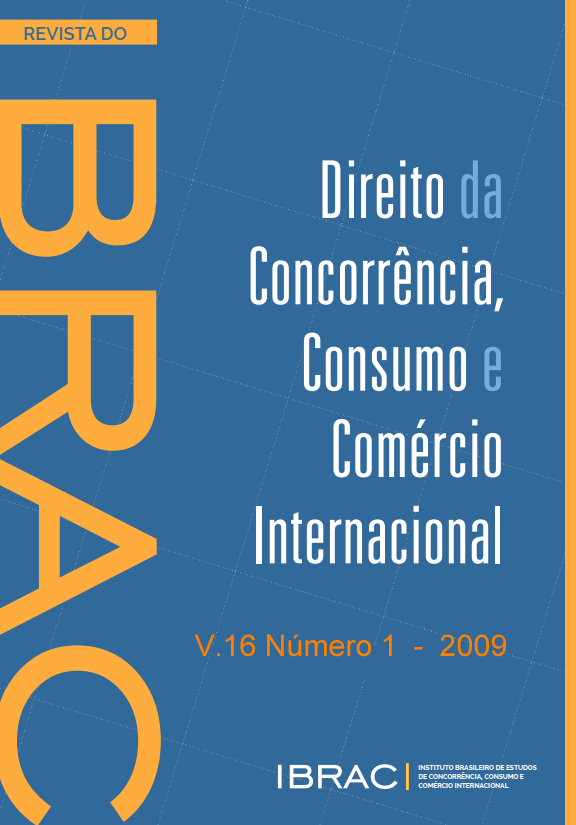Modelos de simulação em análise de atos de concentração
Contenido principal del artículo
Resumen
O julgamento do Ato de Concentração Nestlé-Garoto, em fevereiro de 2004, trouxe para a análise antitruste no Brasil a aplicação de modelos de simulação dos efeitos de fusõ es e aquisiçõ es sobre os preços. As primeiras contribuiçõ es teó ricas relevantes para o uso desta técnica datam da metade dos anos 90. Werden e Froeb (1994) propuseram a simulação para mercados com produtos diferenciados usando o modelo de Bertrand. Posteriormente, Epstein e Rubinfeld (2001) fizeram aplicação semelhante usando o modelo de Cournot
Descargas
Detalles del artículo

Esta obra está bajo una licencia internacional Creative Commons Atribución 4.0.
Citas
BAIN, J. Barriers to new competition. Harvard University Press, 1956.
CROOKE, P.; FROEB, L.; TSCHANTZ, S.; WERDEN, G. Effects of assumed demand form on simulated postmerger equilibria. Review of Industrial Organization, November, 1999.
EPSTEIN, Roy J.; RUBINFELD, Daniel L. Merger simulations: a simplified approach with new applications. Antitrust Law Journal, 2001, p. 883-919.
FROEB, Luke. Merger simulation disciplined by Daubert II. 2004. Disponível em: http://www.ftc.gov/speeches/other/040129froeb.pdf. Acesso em: 29 jan. 2004.
HAUSMAN, Jerry; LEONARD, Gregory. Economic analysis of differentiated products mergers using real world data. Geo. Mason Law Review, 5, 1997, p. 321-346.
HAUSMAN, Jerry; LEONARD, Gregory; ZONA, J. Douglas. Competitive analysis with differentiated products. Annales d’économie et de statistique, 34, 1994, p. 159-180.
JACQUEMIN, A.; SLADE, M. E. Cartels, Collusion, and horizontal merger. In: SCHMALENSEE, R.; WILLIG, R. (ed.). Handbook of industrial organization. Amsterdam: North-Holland, 1989. v. I., p. 415-473.
KAYSEN, C.; TURNER, D. Antitrust policy: an economic and legal analysis. 1959.
MATSUMURA, E. H.; MELLO, M. F. Conluio tácito, efeitos coordenados e preços predatórios. In: FIUZA, E. P. S.; MOTTA, R. S. (org.). Métodos quantitativos em defesa da concorrência e regulação econômica. IPEA/SDE-MJ, 2006.
PIONER, H. M.; PINHEIRO, M. C. Margens de erro e eficiências em fusões. In: FIUZA, E. P. S.; MOTTA, R. S. (org). Métodos quantitativos em defesa da concorrência e regulação econômica. IPEA/SDE-MJ, 2006.
SANTACRUZ, Ruy. Prevenção antitruste no Brasil. Tese de doutoramento apresentada ao IE/UFRJ, 1998.
SCHEFFMAN, David. Whither merger simulation? Ana ABA section of antitrust law “Brown Bag” Program Held January 29, 2004. Disponível em: http://www.antitrustsource.com. Acesso em: 29 jan. 2004.
SCHEFFMAN, David; COLEMAN, Mary. FTC Perspectives on the Use of econometric analyses in antitrust cases. Disponível em: http://www.ftc.gov. Acesso em: 2002.
SCHERER, F. M. The posnerian harvest: separating wheat from chaff. Yale Law Journal, 1976, n. 86.
SHAPIRO, Carl. Mergers with differentiated products. Antitrust, Spring, 1996, p. 23-30.
STIGLER, G. A Theory of oligopoly. Journal of Political Economy, 72: 44-61, 1964.
TIROLE, J.; IVALDI, M. B.; JULLIEN, P.; REY, P.; SEABRIGHT, P. The economics of tacit collusion, final report for DG Competition, European Commission, 2003.
WERDEN, Gregory J. Simulating the effects of differentiated product mergers: a practical alternative to structural merger policy. Geo. Mason Law Review, 5, 1997a, p. 363-386.
WERDEN, Gregory J. Simulating unilateral competitive effects from differentiated products mergers. Antitrust, Spring, 1997b, p. 27-31.
WERDEN, Gregory J.; FROEB, Luke M. The effects of merger in differentiated products industries: logit demand and merger policy. Journal of Law, Economics and Organization, v. 10, 1994.
WERDEN, Gregory J.; FROEB, Luke M. Simulations as an alternative to structural merger policy in differentiated product industries. In: COATE, Malcolm B.; KLEIT, Andrew N. (eds.). The Economics of the Antitrust Process. 1996. Simulations as an alternative to structural merger policy
in differentiated product industries, in The Economics of the Antitrust Process (Malcolm B. Coate and Andrew N. Kleit, ed.)
WERDEN, Gregory J.; FROEB, Luke M. Calibrated economic models add focus, accuracy, and persuasiveness to merger analysis. The pros and cons of merger control, The 10th Anniversary of the Swedish Competition Authority, 2002. Calibrated economic models add focus, accuracy, and persuasiveness to merger analysis. The pros and cons of merger control, The 10th Anniversary of the Swedish Competition Authority.

